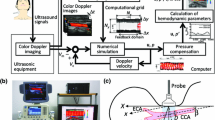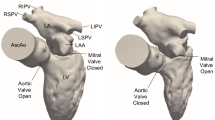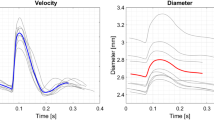Abstract
Two-dimensional ultrasonic-measurement-integrated (2D-UMI) simulation correctly reproduces hemodynamics even with an inexact inflow velocity distribution. This study aimed to investigate which is superior, a two-dimensional ordinary (2D-O) simulation with an accurate inflow velocity distribution or a 2D-UMI simulation with an inaccurate one. 2D-O and 2D-UMI simulations were performed for blood flow in a carotid artery with four upstream velocity boundary conditions: a velocity profile with backprojected measured Doppler velocities (condition A), and velocity profiles with a measured Doppler velocity distribution, a parabolic one, and a uniform one, magnitude being obtained by inflow velocity estimation (conditions B, C, and D, respectively). The error of Doppler velocity against the measurement data was sensitive to the inflow velocity distribution in the 2D-O simulation, but not in the 2D-UMI simulation with the inflow velocity estimation. Among the results in conditions B, C, and D, the error in the worst 2D-UMI simulation with condition D was 31 % of that in the best 2D-O simulation with condition B, implying the superiority of the 2D-UMI simulation with an inaccurate inflow velocity distribution over the 2D-O simulation with an exact one. Condition A resulted in a larger error than the other conditions in both the 2D-O and 2D-UMI simulations.







Similar content being viewed by others
Abbreviations
- b :
-
Unit vector along the ultrasound beam
- D :
-
Inlet diameter
- e :
-
Error of the Doppler velocity
- f :
-
Feedback signal
- \(K_{\text{v}}^{*}\) :
-
Feedback gain
- L :
-
Characteristic length
- (N x , N y ):
-
Grid points of the computational grid
- p :
-
Pressure
- t :
-
Time
- U :
-
Characteristic velocity
- u = (u, v):
-
Velocity vector
- u in :
-
Cross-sectional average inflow velocity
- u ref :
-
Representative velocity for normalization
- V c :
-
Computed Doppler velocity
- V m :
-
Measured Doppler velocity
- (x, y):
-
Coordinates in the computational domain
- (X, Y):
-
Coordinates in the ultrasound color Doppler image
- α :
-
Net ultrasound beam angle
- β :
-
Rotation angle of the image
- Δt :
-
Computational time increment
- (Δx, Δy):
-
Spatial resolution of the computational grid
- θ :
-
Ultrasound beam angle
- μ :
-
Viscosity
- ρ :
-
Density
- τ :
-
Wall shear stress
- Ω :
-
Region of interest
- Ω f :
-
Feedback domain
- Ω q :
-
Monitoring domain
- ave:
-
Spatial-averaged value
- - :
-
Time-averaged value
References
Ford MD, Xie YJ, Wasserman BA, Steinman DA (2008) Is flow in the common carotid artery fully developed? Physiol Meas 29:1335–1349
Funamoto K, Hayase T (2013) Reproduction of pressure field in ultrasonic-measurement-integrated simulation of blood flow. Int J Numer Methods Biomed Eng 29:726–740
Funamoto K, Hayase T, Saijo Y, Yambe T (2006) Numerical study on variation of feedback methods in ultrasonic-measurement-integrated simulation of blood flow in the aneurysmal aorta. JSME Int J Ser C 49:144–155
Funamoto K, Hayase T, Saijo Y, Yambe T (2008) Numerical experiment for ultrasonic-measurement-integrated simulation of three-dimensional unsteady blood flow. Ann Biomed Eng 36:1383–1397
Funamoto K, Hayase T, Saijo Y, Yambe T (2009) Numerical experiment of transient and steady characteristics of ultrasonic-measurement-integrated simulation in three-dimensional blood flow analysis. Ann Biomed Eng 37:34–49
Funamoto K, Hayase T, Saijo Y, Yambe T (2011) Numerical analysis of effects of measurement errors on ultrasonic-measurement-integrated simulation. IEEE Trans Biomed Eng 58:653–663
Funamoto K, Hayase T, Shirai A, Saijo Y, Yambe T (2005) Fundamental study of ultrasonic-measurement-integrated simulation of real blood flow in the aorta. Ann Biomed Eng 33:415–428
Hayase T, Humphrey JAC, Greif R (1992) A consistently formulated QUICK scheme for fast and stable convergence using finite-volume iterative calculation procedures. J Comput Phys 98:108–118
Hoi Y, Wasserman BA, Lakatta EG, Steinman DA (2010) Carotid bifurcation hemodynamics in older adults: effect of measured versus assumed flow waveform. J Biomech Eng 132:071006
Hoi Y, Wasserman BA, Lakatta EG, Steinman DA (2010) Effect of common carotid artery inlet length on normal carotid bifurcation hemodynamics. J Biomech Eng 132:121008
Kamenskiy AV, Dzenis YA, Mactaggart JN, Desyatova AS, Pipinos II (2011) In vivo three-dimensional blood velocity profile shapes in the human common, internal, and external carotid arteries. J Vasc Surg 54:1011–1020
Kato T, Funamoto K, Hayase T, Sone S, Kadowaki H, Shimazaki T, Jibiki T, Miyama K, Liu L (2014) Development and feasibility study of a two-dimensional ultrasonic-measurement-integrated blood flow analysis system for hemodynamics in carotid arteries. Med Biol Eng Comput 52:933–943
Manbachi A, Hoi Y, Wasserman BA, Lakatta EG, Steinman DA (2011) On the shape of the common carotid artery with implications for blood velocity profiles. Physiol Meas 32:1885–1897
Morbiducci U, Gallo D, Massai D, Consolo F, Ponzini R, Antiga L, Bignardi C, Deriu MA, Redaelli A (2010) Outflow conditions for image-based hemodynamic models of the carotid bifurcation: implications for indicators of abnormal flow. J Biomech Eng 132:091005
Moyle KR, Antiga L, Steinman DA (2006) Inlet conditions for image-based CFD models of the carotid bifurcation: is it reasonable to assume fully developed flow? J Biomech Eng 128:371–379
Patankar SV (1980) Numerical heat transfer and fluid flow. Hemisphere Pub. Corp, Washington
Schneider GE, Zedan M (1981) A modified strongly implicit procedure for the numerical solution of field problems. Numer Heat Transf 4:1–19
Steinman DA (2002) Image-based computational fluid dynamics modeling in realistic arterial geometries. Ann Biomed Eng 30:483–497
The Joint Committee of “The Japan Academy of Neurosonology” and “The Japan Society of Embolus Detection and Treatment” on Guideline for Neurosonology (2006) Carotid ultrasound examination. Neurosonology 19:49–69
Tortoli P, Michelassi V, Bambi G, Guidi F, Righi D (2003) Interaction between secondary velocities, flow pulsation and vessel morphology in the common carotid artery. Ultrasound Med Biol 29:407–415
Wake AK, Oshinski JN, Tannenbaum AR, Giddens DP (2009) Choice of in vivo versus idealized velocity boundary conditions influences physiologically relevant flow patterns in a subject-specific simulation of flow in the human carotid bifurcation. J Biomech Eng 131:021013
Acknowledgments
Part of this study was supported by JSPS KAKENHI Grant Number 24360064 and JST Adaptable & Seamless Technology Transfer Program through Target-driven R&D (A-STEP) (AS251Z01013P). The authors thank to Mr. Tadashi Shimazaki, Mr. Takao Jibiki, and Mr. Koji Miyama at GE Healthcare Japan Corporation, for their contribution on exporting ultrasonic measurement data for hemodynamic analysis. All computations were performed using the supercomputer system at the Advanced Fluid Information (AFI) Research Center, Institute of Fluid Science, Tohoku University.
Author information
Authors and Affiliations
Corresponding author
Rights and permissions
About this article
Cite this article
Kato, T., Sone, S., Funamoto, K. et al. Effects of inflow velocity profile on two-dimensional hemodynamic analysis by ordinary and ultrasonic-measurement-integrated simulations. Med Biol Eng Comput 54, 1331–1339 (2016). https://doi.org/10.1007/s11517-015-1376-6
Received:
Accepted:
Published:
Issue Date:
DOI: https://doi.org/10.1007/s11517-015-1376-6




